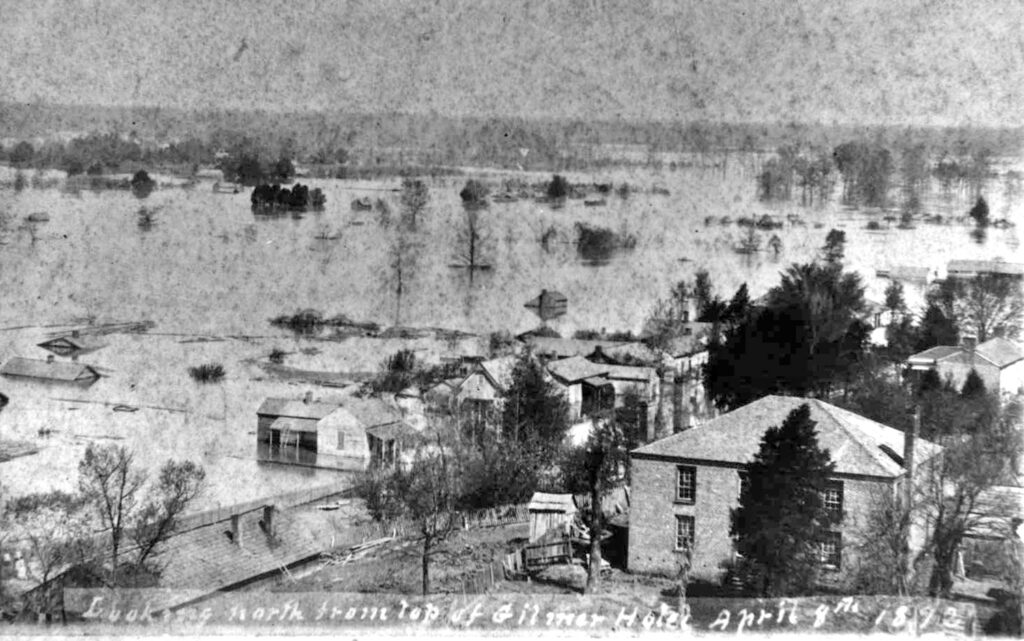
In Thursday’s Dispatch, Jessica Lindsey wrote of the 50th anniversary of the devastating Tombigbee flood of 1973. The Tombigbee Valley has a long history of high water and floods. The most devastating of those past floods were in 1847 and 1892. In the Tombigbee flood of 1847, entire towns were all but washed away, and in 1892 there was a horrible loss of life. In 1847 no one needed a river gage to know how bad the flood was. That most devastating flood on the Upper Tombigbee was known as “the Great Freshet of 1847.” Almost the entire town of Colbert (just south of Barton Ferry in Clay County), and much of the towns of West Port (where the Tenn-Tom channel cuts old Highway 82 to make The Island) and Nashville (on the river south of Columbus), were washed away.
The Columbus Democrat reported on December 18, 1847:
“Unparalleled Freshet — Great Loss of Property &c — The immense quantity of rain which we have had recently, commencing on the night of Thursday week last and ending the Sunday following, has caused our water courses to rise to an unprecedented height. We have not seen that respected and venerable gentleman, oldest inhabitant, recently, but we understand he gives it up, and admits that the Tombigby never before within his recollection rose so high, spread so wide or put on the appearance of an inland sea as it has done this week. The river commenced rising early on yesterday week and continued rising with great rapidity for six days. On Wednesday evening it reached the maximum height, about one foot above the rise of the great freshet in 1841. All the lowlands have been submerged to a frightful extent. From the foot of the hill on Main Street a sheet, or rather miniature sea of water, is spread out to the view, unbroken except by the tall trees for miles to the west. Many families who reside near the river have been compelled to leave their houses, which the water has surrounded, filling some of them to a depth of many feet. The steamer Putman was able Wednesday morning to take a new route. The engineer turned the bridge on the west side and steering over the old field made a shortcut across the bend, into the main stream some distance above the bridge (The 1842 bridge built by enslaved architect/engineer Horace King off the bluff at Fourth Avenue South). Where the Putman ploughed its way through water ten feet was dry land the week before.”
The Putman made it through the flood but in the following March hit a snag and sank at Moore’s Bluff south of Columbus.
“Immense damage, we apprehend, has been done on all the plantations near the river. We have heard of the loss of several hundred bales of cotton and stock, &c., of every kind to an almost incalculable amount. At Westport alone, where there was a large quantity of cotton stored away, the loss has been estimated at from eighty to one hundred thousand dollars. What makes the loss greater is the fact that but a small portion of the cotton crop had been shipped; most of it was stored away at different landings on the river and as much of it could not be removed in time, the water, rising with unprecedented rapidity, swept if off, rendering all the efforts of the owners to save it to no avail.
“Most of the bridges in the county have either been swept away or considerably injured. The Columbus Bridge is shattered a little at the west end, but the damage can be easily repaired. The bridge east of the town over the Luxapalila has been swept off. We learn it has floated down the stream and lodged against Maj. Blewett’s bridge, which has been in danger, if that too has not been carried off. But we are yet without information as to particulars and cannot today go into a detailed account of the many and serious losses sustained from this unprecedented freshet. Fortunately no human lives have been lost — at least we heard of none. The river has been falling gradually since Wednesday last, but it will be several days before it gets within its banks.”
However, it is the flood of 1892 that is usually considered the benchmark river crest. The Tombigbee crested at Columbus on April 8, 1892, at 42.6 feet on the Columbus gage, which was 13.6 feet above flood stage. Flood waters were said to have reached what is now the parking lot across Main Street from Harvey’s Restaurant. The flood of 1892 cut off all roads leading to Columbus and severely damaged the railroads, washing out several railroad trestles. Washouts created two lakes that still exist on what is now The Island across from Columbus. The flooded Tombigbee backed up the Luxapalila until it reached the south east part of Mississippi University for Women campus and the former site of Palmer Home.
On April 14 the Birmingham Age-Herald reported: “A sea of water; a sea of sorrow; a sea of distress; a sea of illuminations; a sea of wailings; a sea of washed up land; a sea of miles of ruined railroads, and this is only a part of the terrible flood which recently devastated the suburbs of Columbus, Miss., and many square miles of the surrounding country. The water extended as far as the eye could reach over the lands in the counties of Lowndes and Clay for several days …”
The flood attracted national attention and its devastation was best described in the following account that appeared in several newspapers from New York to California in the days following the flood”s crest on April 8, 1892:
SWEPT BY FLOODS
Appalling Loss of Life and Property in the South
A dispatch from Columbus, Miss., says: The recent heavy rains have swollen all streams in this section of the country to a point never before known, and as a result the destruction of life and property has been frightful. All farms along the Tombigbee River valley have been abandoned, houses of all kinds washed away. All fencing is gone and cattle and mules by hundreds have been drowned. Many floating houses passed down the river.
Every available craft has been used day and night relieving the sufferers, carrying out food and bringing in the destitute people. On one small mound there were forty people and as many more cattle and mules. On another there were seventy people and cattle by the hundreds. The colored people on all the lowlands have lost everything on earth they had and there are hundreds of them being fed by the city. Twelve colored men have been drowned within three miles of this city. At points on the river below here the loss of life is very large.
The railroads have abandoned all trains westward and there are many washouts. The trestles are swept away and all of the roads have large forces repairing damages, but it will be a week before trains will be running.
One rescuing party was upset, and three colored boys were drowned three miles above town. All the others climbed trees and were found. Another rescuing party was upset and spent twenty-three hours in the trees. Seventy-five colored people are known to have been drowned, and many more will be found dead when the waters subside.
The greatest loss of life and injury to property was along the line of the Tombigbee River. This river is not large enough in the dry season to float a small steamboat, but now it is 10 miles wide. Its valley is extremely fertile, and is thickly populated.
All of the plantations along its border for four or five miles are submerged from five to twenty feet. So great is the devastation in Northern Mississippi that the people have appealed to Congressman Allen for assistance. … The greatest suffering is among the colored people. Thirty the lowest estimate of the number of drowned in Alabama.”
Floods were always a way of Life along the Tombigbee. Since the completion of the Tennessee-Tombigbee Waterway in 1985, the floods have not been as frequent or as bad but it would be a horrible mistake to ever underestimate the destructive potential of the Tombigbee.
Rufus Ward is a Columbus native a local historian. E-mail your questions about local history to Rufus at [email protected].
You can help your community
Quality, in-depth journalism is essential to a healthy community. The Dispatch brings you the most complete reporting and insightful commentary in the Golden Triangle, but we need your help to continue our efforts. In the past week, our reporters have posted 37 articles to cdispatch.com. Please consider subscribing to our website for only $2.30 per week to help support local journalism and our community.




